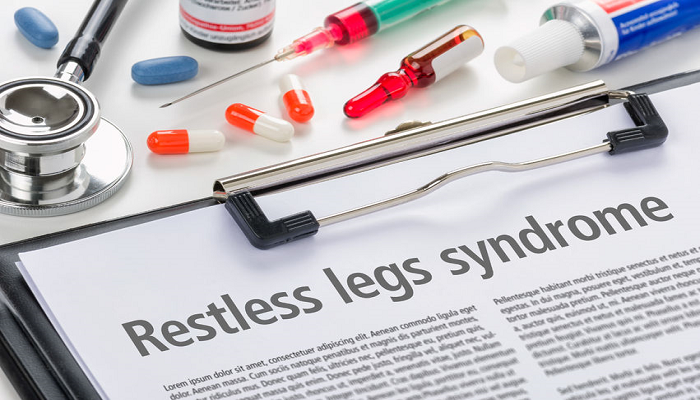Restless Leg Syndrome and Fibromyalgia

Restless leg syndrome and fibromyalgia can both cause issues for sufferers. As if fibromyalgia doesn’t cause enough distress when you’re awake, it often disrupts your sleep as well. It’s common for sufferers to report difficulty falling and staying asleep due to pain, but restless leg syndrome is another condition that can lead to frequent sleep disruptions. This condition can occur while you’re sound asleep, waking you up multiple times in a single night.
It can also strike right as you start to relax your muscles and fade into sleep, preventing you from falling into a deep, restorative sleep state. Either way, you start your day feeling even more exhausted than you were at the start of the night.
The connection between fibromyalgia and restless leg syndrome lies in the connection between overactive nerves and the neurological system as well. It can be associated with neurological disorders, and just like with other parts of the fibro body, restless leg syndrome can also be a result of over-active nerves, something you hear often when living with fibromyalgia, right?
There is no scientific proof that fibromyalgia will causes this condition in itself, but the connection is strong enough that all fibromyalgia patients should understand how to treat this symptom and sleep disruption it can cause, if and when it does occur.
Understanding Restless Leg Syndrome
Just as an epileptic seizure is caused by abnormal activity in the brain, restless leg syndrome is caused by abnormal activity in leg muscles. The legs simply want to move in awkward ways, and it typically occurs when your body is relaxed. You want to remain still and sleep, but your muscles decide it’s time to jerk, twitch, shake, or otherwise take action.
This creates a variety of uncomfortable sensations from burning and tingling to the sensation of something crawling over your skin. Like many fibromyalgia symptoms, different people report different symptoms. What they all have in common is the experience of their legs feeling and acting restless when their body is relaxed and still.
In my case, I also have restless feet and toes. I find this happens even more if I am not wearing shoes or if it is late at night or first thing in the morning. Sometimes I will go put my feet in a warm foot bath with salts and liquid magnesium and then massage them to help stop the feet and toes from wanting to move about. * (magnesium article link at bottom of this page)
Can You Treat Restless Leg Syndrome?

Not
all cases require treatment. If it is more of
an occasional annoyance that you can overcome by moving to a new
position or simply waiting for the restless activity to subside, then
you may decide not to press for treatment options. You should still
mention it to your doctor because there’s a chance that it’s a side
effect of medications or supplements that you’re taking to control other
fibromyalgia symptoms.
If your restless leg events occur
frequently and leave you exhausted and unable to function,
then you should experiment with treatment options. You can start by
working with your doctor and checking for nutritional deficiencies. Be
careful not to ingest stimulants like caffeine close to bedtime. They
may also check you for other medical conditions known to cause restless legs or feet.
In case of any nutritional deficiencies ,we want
to be sure we are getting enough of the B-Complex family of vitamins,
B-12 in the proper form, and magnesium (topical form is great) For B-12 in the most natural form, we like Methyl or Hydroxy form. (Avoid B12 in the form of Cynocobalamin)
You
can also meet with a physical therapist to learn massage techniques
that are proven to relax the leg muscles to stop the activity.
Alternating hot and cold can be helpful, only to tolerance of course.
You may also try using an electrical stimulation device like a tens unit before bed .
I also recommend trying
different forms of light compression. Often times people will say “won't
that hurt?” but light compression wear is designed to increase blood
flow and circulation, so it can be helpful with restless legs and feet.
It has been shown that wrapping the feet can be helpful in decreasing
symptoms.
You may need to go through a sleep study before other various treatments are prescribed.
We also see a great correlation between exercise,
movement and reducing the symptoms of restless leg syndrome. It doesn't
have to be more than you can handle. Follow me on the Fibro Fit People fitness page where I show exercises that are both safe and effective for increasing circulation and blood flow. Check out the video section of that page.
You see, sometimes when we are thinking about solutions to any symptom,
we have to think in terms of how that symptom itself thinks. In a
sense, how it displays itself. You get what I mean? What is that symptom
saying to us? In the case of restless leg syndrome, it is saying “I
want to move” “I need to move right now” So we have to beat it at it's
own game by giving it some kind of movement every day, whatever is right
for each of us.
Thank you for reading. Lisa.
Related Articles:
- Magnesium and Fibromyalgia
- Foot pain and Fibromyalgia
- Muscle Spasms and Fibromyalgia
- Nerve pain in Fibromyalgia
Before you leave, my sitemap can provide you with a "God's-eye" view of this website laid out in "outline format".
Stay connected by joining our unique Email here at Fibro Repair Email
Home > Fibromyalgia Symptoms > Restless Leg Syndrome and Fibromyalgia
Didn't find what you were looking for? Search for it:
living-smarter-with-fibromyalgia.com
©2013-2024 All Rights Reserved
FibroFitPeople, LLC ;©2024 All Rights Reserved









